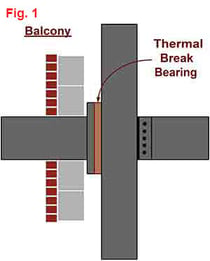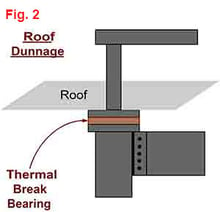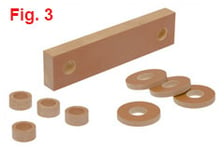Thermal Break Bearings
Thermal Breaks are bearings that separate steel to stop the escape of energy from a structure. Energy, in this case, means heat. Typically, the bearing will stop the escape of heat. Example, and warm apartment house in the winter. But it can also be used to keep heat out. Example, a Refrigerated Warehouse chilled to 20°F in the summer.
Energy, in this case, means heat. Typically, the bearing will stop the escape of heat. Example, and warm apartment house in the winter. But it can also be used to keep heat out. Example, a Refrigerated Warehouse chilled to 20°F in the summer.
Steel is a very good conductor of energy, and heat will transfer if it is able. Any steel beam that passes through an exterior wall has the potential to let heat escape and will do that whenever the temperature is unequal between the building’s interior and the outside environment.
See Fig. 1 and 2.
This transfer also occurs if a steel column is flush against an exterior block wall. It does not need to pass through, but heat will transfer from the steel into the  block as long as the temperature is lower in the block. Assuming the block is an outside wall the heat will continue to dissipate into the atmosphere and the energy escape will continue indefinitely. This energy transfer is negated by inserting a Thermal Break Bearing between the steel column and the block.
block as long as the temperature is lower in the block. Assuming the block is an outside wall the heat will continue to dissipate into the atmosphere and the energy escape will continue indefinitely. This energy transfer is negated by inserting a Thermal Break Bearing between the steel column and the block.
Hardware Bearings
Even with the Bearing in place some thermal transfer will be conducted through the structural bolts. To counteract this the Architect or Engineer will specify thermal break washers and bushings. Fig. 3.

Made of the same material as the bearing, the washer and bushing will isolate the steel bolt and nut to eliminate any residual energy transfer. The Thermal Bushings and Washers do add cost. However, the benefit appears when the entire system of Thermal Break Insulation is compared with the cost of energy saved. In most cases the Thermal Break System will pay for itself, especially considering it can last for the lifetime of the structure.




